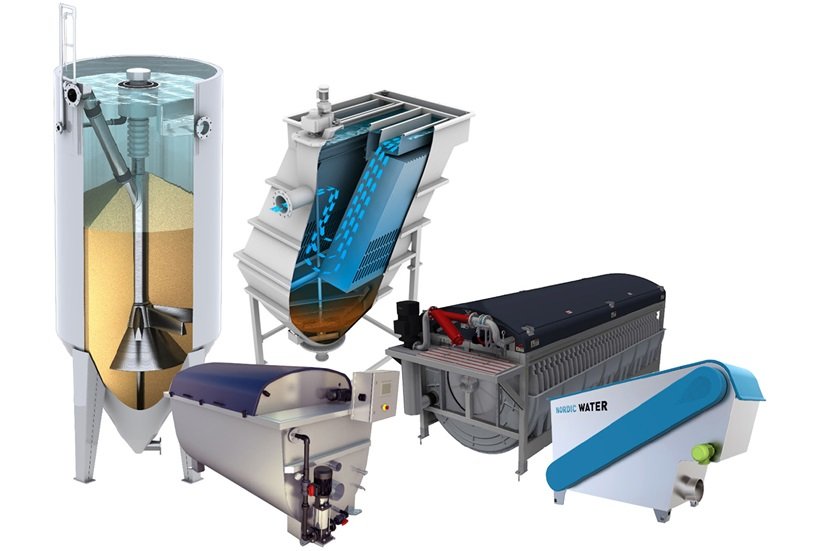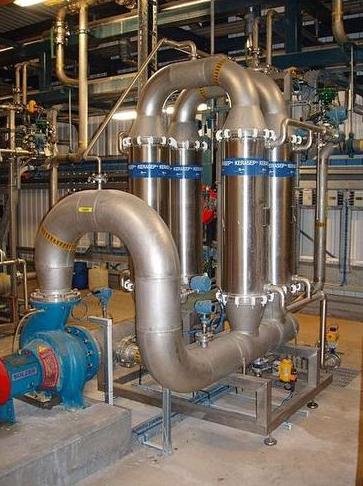Industrial Wastewater Treatment: A Step towards a Sustainable Environment
Contents
- Understanding Treatment of Industrial Wastewater
- The Two-Way Method: Chemical and Mechanical Processing Techniques
- Three Steps in the Industrial Wastewater Treatment Process
-
- Secondary Treatment: Biological Purification
- Advanced Purification and Polishing as Tertiary Treatment
- Embracing Recycling of Wastewater: The Way to Sustainability
Understanding Treatment of Industrial Wastewater
Industrial wastewater treatment is becoming more than just a process—it is a necessity in this era of rapid industrialization. It consists of a variety of tools and processes intended to purify wastewater tainted by industrial processes. This treatment is essential for lessening the environmental impact of industrial waste since it guarantees that the water can be safely released into the environment or reused/recycled inside the enterprise.

The Two-Way Method: Chemical and Mechanical Processing Techniques
A variety of chemical and mechanical procedures, each designed to target different contaminants in the water, are used to treat industrial wastewater.
Procedures for Chemical Treatment
In order to successfully remove or neutralize contaminants from wastewater, chemical treatment methods are essential for changing the chemical composition of the wastewater. Every technique has a unique use and benefits depending on the order of treatment.
1. Chemical Precipitation
Chemical precipitation is a widely used method to remove dissolved inorganic substances from wastewater. By adjusting the pH levels or temperature of the wastewater, certain pollutants are transformed into their insoluble forms, precipitating out of the solution. This process is particularly effective for the removal of heavy metals and phosphates, which can be toxic to aquatic life and humans. The precipitated solids can then be separated from the water through sedimentation, flotation, or filtration.
2. The Neutralization Process
In order to bring the pH of the wastewater down to a neutral range, usually around 7, the neutralization procedure is essential to the wastewater treatment process. Wastewater that is too acidic or alkaline can damage infrastructure, destroy aquatic ecosystems, and reduce the efficiency of other treatment methods, which is why this correction is required. Addition of acids or bases to the wastewater is a common method of neutralization. While sulfuric acid can be used to lower pH, lime, or calcium hydroxide, is typically used to elevate pH.
3. Adsorption
Soluble pollutants are extracted from wastewater by the process of adsorption, which involves binding them to the surface of a solid adsorbent. Because of its enormous surface area and strong affinity for organic molecules, such as solvents, detergents, and hazardous chemicals, activated carbon is one of the most widely utilized adsorbents. This process is essential to the treatment of industrial effluents because it is very good at eliminating chemicals that alter water's color, odor, or taste.
4. How to Clean and Use Disinfectants
Disinfection is essential for removing pathogens—bacteria, protozoa, and viruses—from wastewater because they can be extremely dangerous to human health. To make sure that these germs become dormant, chemical disinfectants like chlorine, ozone, or ultraviolet (UV) radiation are frequently utilized. Every disinfectant functions in a different way. For instance, microorganisms become harmless when their DNA is broken by UV light, but their cell walls are destroyed by ozone and chlorine.
5. The Ion Exchange Process
The reversible chemical process known as ion exchange makes it easier for ions to move from a solution into a solid resin. The reason this approach works so well at softening water is that it employs sodium ions rather than the calcium and magnesium ions that generate hard water. Furthermore, fluoride, nitrate, and heavy metals can be eliminated using ion exchange resins.
Methods of Mechanical Filtration
Mechanical filtration techniques use a variety of media to trap or filter out pollutants in order to physically separate particles and other impurities from wastewater.
1. Sand Filters
Using sand as a substrate to trap particles, sand filters are among the earliest and most basic filtration methods. Sand collects debris, silt, and some microbiological pollutants as water passes through it. These filters are used for tertiary treatment, polishing water to eliminate finer particles that have not been caught by previous processes. They can work under pressure or gravity.
2. Ceramic Membranes
A more sophisticated filtration technology, ceramic membranes can remove minuscule particles as small as nanometers. These membranes have a high degree of durability, are immune to heat and chemical stress, and are efficient at filtering out heavy metals, suspended solids, bacteria, and viruses. Applications needing a high level of purification, like repurposing industrial wastewater for process water or even potable water applications, benefit greatly from the use of ceramic membranes.
Industrial wastewater can be treated comprehensively by combining mechanical filtration techniques with chemical treatment processes. Through the integration of these tactics, industries can efficiently mitigate their ecological footprint, adhere to regulatory guidelines, and facilitate the sustainable utilization of water resources.

Three Steps in the Industrial Wastewater Treatment Process
Primary Treatment: The Cornerstone of Water Resource Management
The first step in the wastewater treatment process, primary treatment concentrates on getting rid of physical pollutants. Here, the goal is to mechanically remove large solids and particulate matter before the wastewater is subjected to more advanced treatment.
Sedimentation: This procedure enables heavy solid pollutants to gravitationally settle to the bottom of a sedimentation tank. After that, the settled material—often referred to as sludge—is taken out and sent for additional processing or disposal.
Filtration: To remove big debris that could obstruct later treatment procedures, such as rags, sticks, and other large objects, coarse screens are utilized. Smaller particles can also be captured by using fine screens.
Physical Chemical Processes: In certain circumstances, basic chemical procedures such as pH correction or the addition of coagulants to aid in the removal of suspended solids may also be a part of primary treatment.
Primary treatment effectively reduces the load on the subsequent treatment stages by removing the bulk of physical pollutants, thus preventing potential damage and enhancing the efficiency of finer purification processes.

Secondary Treatment: Biological Purification
By addressing the dissolved organic matter that evades primary treatment, secondary treatment represents a major advancement in the wastewater treatment process. Biological processes are used in this stage to use naturally occurring microorganisms to consume and degrade organic pollutants.
One of the most popular techniques is the "activated sludge process," which involves combining a community of microorganisms with aerated wastewater. The water is purified by the microorganisms because they eat organic matter.
Fixed Film Systems: These systems break down organic pollutants by attaching bacteria to support media, like rocks or plastic. This group includes systems such as revolving biological contactors and trickling filters.
Anaerobic Digestion: Methane and carbon dioxide are released when organic matter is broken down by anaerobic bacteria in the absence of oxygen. Treatment of industrial wastewaters with high strength is a special application for this process.
By drastically lowering the wastewater's organic content, secondary treatment gets it ready for any additional purification needed to meet certain quality requirements.
Advanced Purification and Polishing as Tertiary Treatment
The last cleaning step, known as advanced treatment or tertiary treatment, polishes the wastewater to get rid of any impurities that secondary treatment was unable to completely remove. In order to meet the strictest requirements for reuse or discharge, this stage frequently combines chemical, physical, and biological processes.
Membrane Filtration: To eliminate dissolved solids, some dissolved substances, and fine particulates, techniques such as microfiltration, ultrafiltration, and reverse osmosis are used.
Advanced Oxidation Processes (AOPs): These procedures target materials that are challenging to eliminate through traditional treatment by using oxidants like ozone, hydrogen peroxide, or UV light to break down pollutants at the molecular level.
Ion Exchange: By substituting other, less harmful ions for dissolved ions, such as heavy metals or hardness, this chemical process eliminates those ions.
Removal of Nutrients: Certain treatments aim to eliminate nutrients, particularly phosphorus and nitrogen, which can lead to eutrophication in receiving water bodies.
By the end of tertiary treatment, the wastewater is significantly purified and may be suitable for discharge into sensitive ecosystems, industrial reuse, or even augmentation of potable water supplies, depending on local regulations and treatment efficacy.
These three phases work together to create a strong framework for managing wastewater from industrial processes, safeguarding water supplies, and promoting environmentally friendly industrial practices.

Embracing Recycling of Wastewater: The Way to Sustainability
One particularly notable example of sustainability in industrial operations is wastewater recycling. Industries can save a lot of water, lower operating costs, and lessen their environmental impact by treating and reusing wastewater. Reusing treated water in different industrial processes is made possible by the efficient purification provided by technologies such as ceramic membrane filtration.
In addition to addressing the urgent problem of water pollution, this all-encompassing method of treating and recycling industrial wastewater also helps to ensure the sustainable use of water resources. Through a thorough comprehension and application of these treatment techniques, industries can significantly contribute to safeguarding the environment, promoting public health, and guaranteeing the accessibility of clean water for upcoming generations.